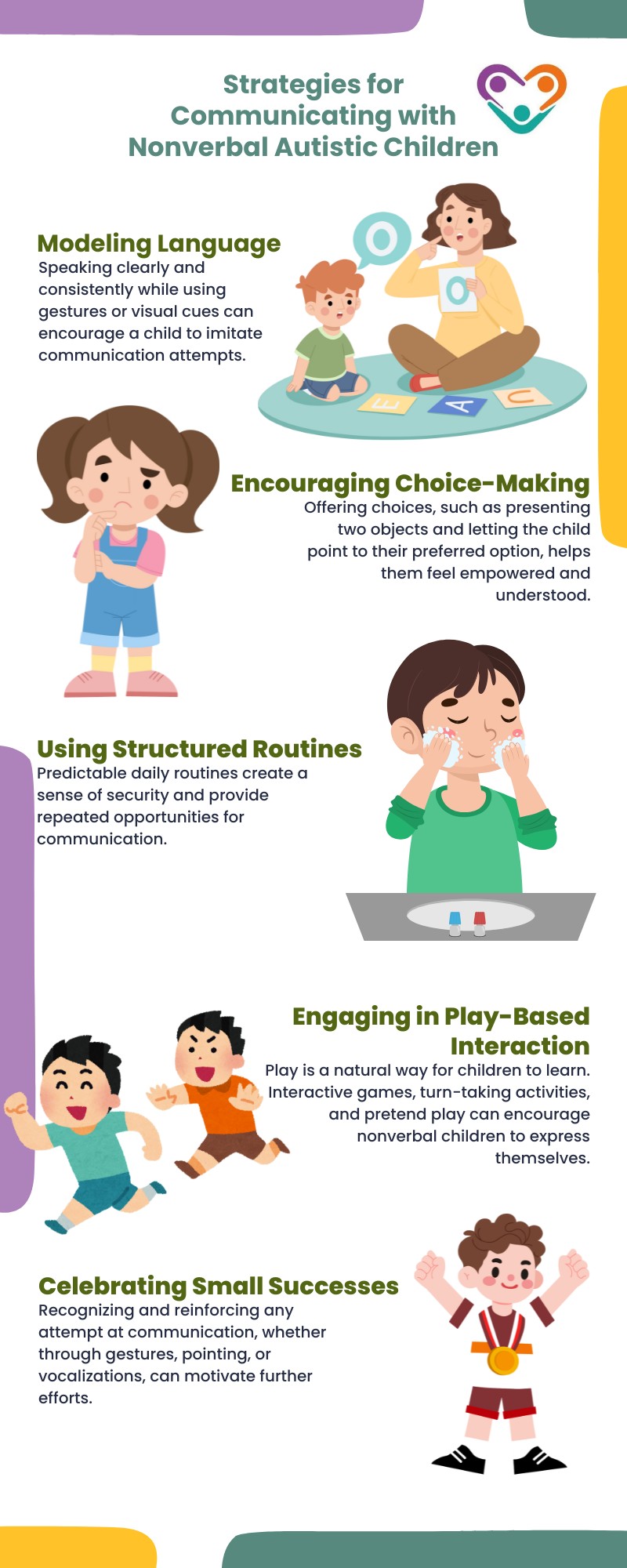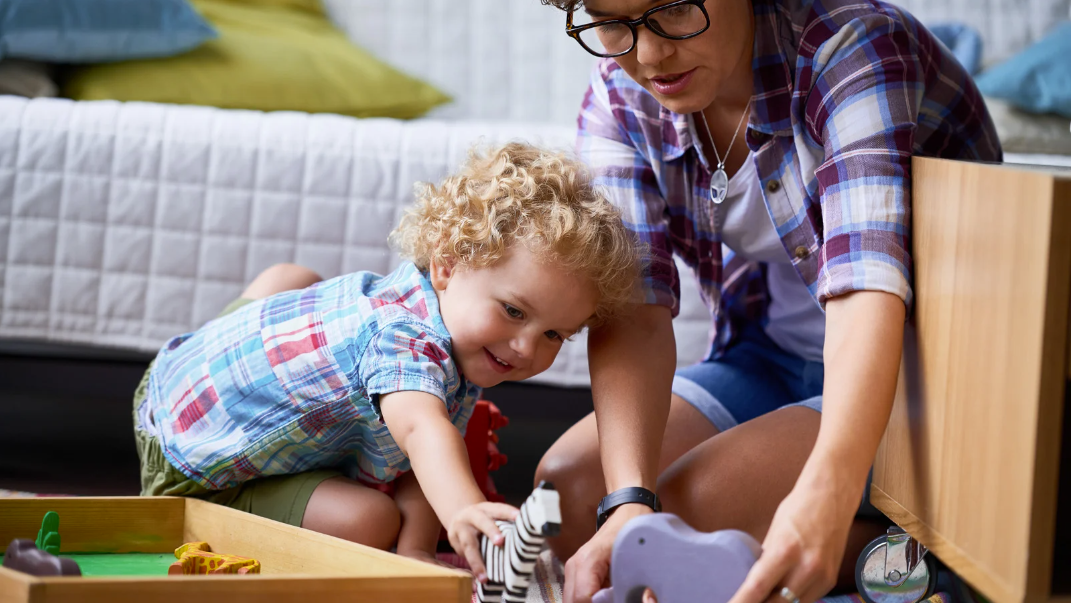Communicating with nonverbal children, particularly those with autism, requires patience, creativity, and an understanding of their unique ways of expressing themselves.
While they may not use spoken language, nonverbal children still have thoughts, feelings, and needs they want to share. By recognizing their communication styles and using effective strategies, caregivers, educators, and therapists can foster meaningful connections and help these children navigate the world more easily.
Understanding Nonverbal Communication
Every child with autism is unique, and so are their communication styles. Some may use gestures, facial expressions, or body language, while others rely on visual aids, assistive technology, or alternative communication systems like sign language.
Some children use a combination of methods, adapting their approach based on the situation. The key to effective communication is to observe and respond to these cues, creating a supportive and interactive environment.
That said, one of the most common questions parents ask is whether their nonverbal child will eventually learn to speak. Research suggests that many nonverbal children with autism do develop some level of spoken language over time, though the timeline varies.
Studies indicate that about 30% of nonverbal autistic children begin to speak by age 4, with that number increasing to 50% by age 5, 70% by age 6, and 80% by age 7 or older.
While these statistics are encouraging, it’s important to remember that speech is just one form of communication. Many children who remain nonverbal find effective ways to express themselves through alternative communication methods.
Rather than focusing solely on verbal speech, caregivers should prioritize overall communication skills. A child who can express their needs and emotions through gestures, pictures, or assistive devices is just as capable of meaningful interaction as one who speaks.
Supporting your autistic child in social situations goes beyond just verbal communication. As discussed in our article “7 Ways You Can Support Your Autistic Child in Social Situations,” it’s essential to prioritize a variety of communication methods. Focusing on overall communication skills, such as gestures, pictures, or assistive devices, ensures that your child has the tools they need to express their needs and emotions effectively.
Strategies to Support Communication
Helping nonverbal children communicate involves a combination of individualized approaches, visual supports, and assistive technologies. The right approach depends on the child’s strengths, preferences, and developmental stage.
Individualized Communication Approaches
Every child responds differently to communication strategies, so it’s essential to tailor methods to their needs. Working closely with therapists and specialists can help identify the most effective techniques. Some strategies that have been successful for nonverbal children include:

Since each child is different, what works for one may not work for another. Trial and error, along with professional guidance, can help determine the best approach for an individual child.
Visual Supports and Assistive Technologies
Visual supports are powerful tools for enhancing communication in nonverbal children. These tools provide a structured and consistent way for children to express their needs, understand routines, and engage with others.
Some commonly used visual supports include flashcards, visual schedules, communication boards, and picture exchange communication systems. At the same time, technology can further enhance communication for nonverbal children. Assistive technologies include:
- Speech-Generating Devices: These devices produce spoken words when a child selects images or symbols.
- Tablet-Based Communication Apps: Many apps use touch screens to allow children to select words, phrases, or images to communicate.
- Augmentative and Alternative Communication (AAC) Systems: These systems combine multiple communication methods, including sign language, pictures, and text-to-speech tools.
Incorporating these tools allows nonverbal children to develop more confidence in their ability to communicate and interact with others.
Effective Communication Techniques
Recognizing and responding to nonverbal cues is one of the most important skills for caregivers and educators. Many nonverbal children communicate using hand gestures, facial expressions, and body language. Being attentive to these signals fosters connection and encourages further interaction.
One effective way to engage nonverbal children is through imitation. Mirroring their sounds, gestures, or facial expressions shows that their attempts at communication are being acknowledged. This technique helps build trust and encourages the child to interact more.
For example, if a child claps their hands, a caregiver can clap back and smile. Over time, this back-and-forth interaction can evolve into more complex communication exchanges.
Nonverbal children often benefit from social engagement activities that emphasize nonverbal communication.
Playing games that involve turn-taking, using shared attention activities (such as looking at a book together), or incorporating music and movement can enhance interaction and communication skills.
For some nonverbal children, learning a structured communication system can be beneficial. Two widely used methods include:
- Sign Language: A fully developed language using hand signs, facial expressions, and body movements.
- Makaton: A simplified communication system that combines signs, symbols, and speech to support language development.
Both systems provide children with an accessible way to communicate their thoughts and needs, reducing frustration and increasing independence.
To effectively support children with autism, it’s essential to understand how various factors, like sleep patterns, play a role in their development. Articles like “How Autism Affects Sleep Patterns in Children“ explore the connections between sleep disruptions and behavioral challenges, offering valuable insights for parents and caregivers.
Encouraging Expression and Connection
Helping a nonverbal child communicate isn’t just about teaching them to speak — it’s about finding ways for them to express themselves in a way that works for them. Whether through gestures, technology, or sign language, every child has a unique voice.
By embracing different communication methods, creating a supportive environment, and celebrating small victories, caregivers can help nonverbal children connect with the world around them.
Ultimately, communication is about connection, understanding, and ensuring that every child feels heard and valued. At Golden Care Therapy, we are dedicated to providing top-quality ABA therapy tailored to each child’s unique needs. Our compassionate team works closely with families to create meaningful progress and lasting positive change.
We proudly offer ABA therapy in Florida, New Jersey, Indiana, New York, and Georgia. If you’re looking for expert care and a team that truly prioritizes your child’s growth, reach out to us today. Contact us now to get started!
Sources:



